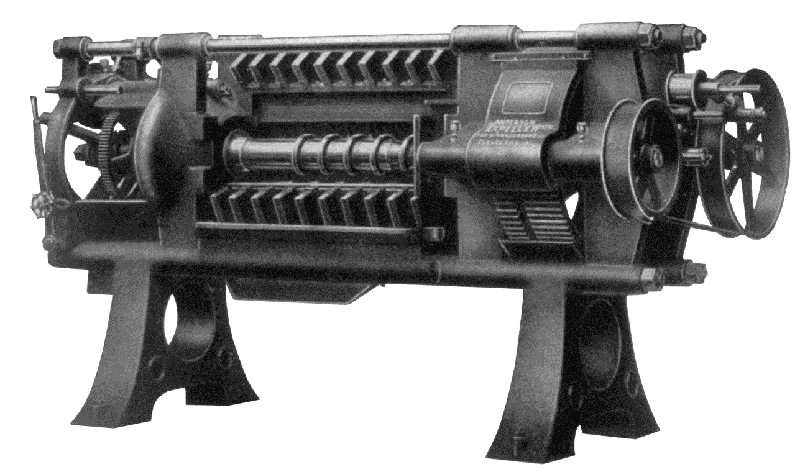The invention of Anderson Expanders
Often when Anderson engineers visit oilseed processing plants to talk to potential clients about their operations, one question inevitably arises: What is the difference between traditional extruders and what Anderson calls its “expander” machines? And sometimes we’ll hear that a competitor told the potential client that Anderson does not make extruders, only expanders. Interesting.
Well, it’s time to set the record straight. Anderson makes both.
Let’s start with a mini-history lesson, leading up to where the term “expander” comes from. First, all mechanical screw presses in the industry today are based on the original design of the first continuous mechanical extractor —the Expeller® — invented in the late-1800s by our founder, Valerius D. Anderson. The applications for this revolutionary technology for seed oil extraction grew to more than 60 oil and fat bearing seeds, nuts, and beans over time. The Expeller’s slotted barrel design became an industry standard, allowing for the efficient phase separation of liquid from solid.
It’s in the accidental modification of the Expeller’s barrel setup that led to the invention of Anderson Expanders. As the story goes, an operator at a customer site had set up an Expeller without the required spacers in the barrel. With the barrel completely sealed, the heat generated by the process was retained within the machine, raising the internal temperature. The corn and starch were cooked and gelatinized, so as the corn discharged from the Expeller, it exploded or expanded. Recognizing the product from the sealed barrel was transformed into something different than when processed in the standard barrel, Anderson engineers got to work on how to apply this new technology. The expanding nature of the end product stuck with the machine and its name, and our Anderson Expander line was born.
How Anderson Expanders work
As the Anderson Expander solid barrel screw machine evolved, Anderson engineers found ways to enhance the cooking process inside the barrel. Essentially, engineers created a continuous pressure cooker, generating a high-pressure environment within the machine to accelerate heat transfer, like a pressure cooker in your kitchen. So, as you increase the pressure, heat transfer becomes more efficient, and your cooking time drops dramatically. The result is we can cook grains and oilseeds in a very short period of time, increasing machine capacity while reducing energy consumption and operational costs. Technically, Anderson Expanders are a type of extruder, since the machine forces materials to be extracted through a die or orifice. Through heat and pressure, however, the material is transformed into a dense yet porous structure, allowing for solvents to access the oil for easier extraction. Clients use our Anderson Solvex Expanders for efficient solvent extraction, with the added benefits of increasing extractor capacity, reducing solvent hold-up in the solids and as a percentage of liquid content, and reducing solvent losses.
All Expanders are Extruders. But not all Extruders are Expanders.
Like the Anderson Solvex Expander, the second set of extruders in our product line is the Anderson Dox (Dry Oilseed Extruder) series. Both product lines are considered extruders because the machines force materials through a die or orifice. The Dox Extruder, however, does not meet the requirements of an expander. Here are the key differences:
The use of steam.
Anderson Dox Extruders are dry machines that force the materials being processed through our high shear discharge. The material is mechanically sheared, generating the frictional heat needed to rupture the seed’s oil-containing bodies. The heat also deactivates harmful enzymes, removes excess moisture, and cooks the proteins for better pressing.
Anderson Solvex Expanders use direct steam injection inside the barrel. The material is mixed with steam to raise the temperature rapidly. Differential pressure between the inside of the barrel of the expander and the atmosphere causes the material to expand or “puff up” as it exits the machine into the lower pressure environment.
Discharge differences.
Anderson Dox Extruders use a high shear cone plug at the discharge to break down the product and make mechanical oil extraction easier. This discharge method generates a direct exchange in the physical aspect of the materials and generates a tremendous amount of frictional heat.
Anderson Solvex Expanders use perforated die plates with die inserts or hydraulic cone chokes to allow for material expansion at the discharge. They expand the product and make it porous, so solvent extraction is more efficient.
Need assistance with your oilseed equipment now?
Do not hesitate to call us at 1(800) 336-4730 or use our contact form.
To differentiate between these two types of machines, the team here at Anderson always refers to the Anderson Solvex product line as expanders and the Anderson Dox series as extruders. So now you know the difference.
To learn more about Anderson expanders and extruders, get the details here:
Anderson’s Dox Extruder
https://www.andersonintl.com/oilseed-equipment/dox-extruder/
Anderson’s Solvex Expander
https://www.andersonintl.com/oilseed-equipment/solvex-expander/
